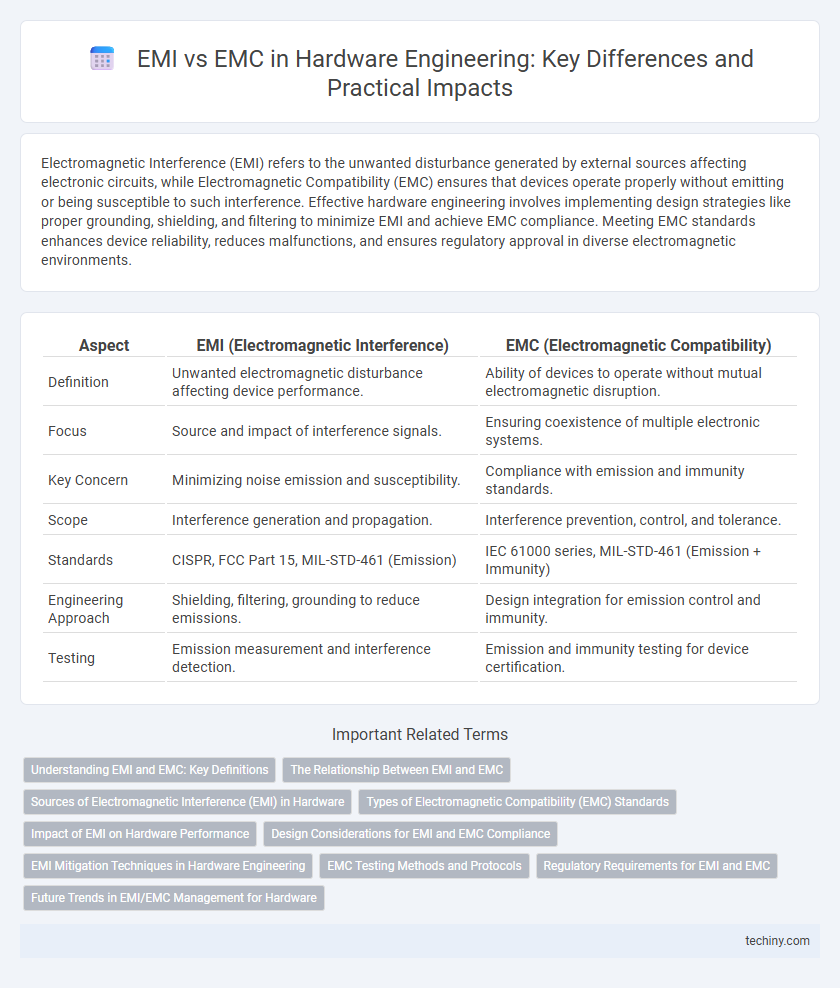Electromagnetic Interference (EMI) refers to the unwanted disturbance generated by external sources affecting electronic circuits, while Electromagnetic Compatibility (EMC) ensures that devices operate properly without emitting or being susceptible to such interference. Effective hardware engineering involves implementing design strategies like proper grounding, shielding, and filtering to minimize EMI and achieve EMC compliance. Meeting EMC standards enhances device reliability, reduces malfunctions, and ensures regulatory approval in diverse electromagnetic environments.
Table of Comparison
| Aspect | EMI (Electromagnetic Interference) | EMC (Electromagnetic Compatibility) |
|---|---|---|
| Definition | Unwanted electromagnetic disturbance affecting device performance. | Ability of devices to operate without mutual electromagnetic disruption. |
| Focus | Source and impact of interference signals. | Ensuring coexistence of multiple electronic systems. |
| Key Concern | Minimizing noise emission and susceptibility. | Compliance with emission and immunity standards. |
| Scope | Interference generation and propagation. | Interference prevention, control, and tolerance. |
| Standards | CISPR, FCC Part 15, MIL-STD-461 (Emission) | IEC 61000 series, MIL-STD-461 (Emission + Immunity) |
| Engineering Approach | Shielding, filtering, grounding to reduce emissions. | Design integration for emission control and immunity. |
| Testing | Emission measurement and interference detection. | Emission and immunity testing for device certification. |
Understanding EMI and EMC: Key Definitions
Electromagnetic Interference (EMI) refers to unwanted electromagnetic signals that disrupt the performance of electronic devices, causing malfunctions or data loss. Electromagnetic Compatibility (EMC) ensures that equipment operates correctly in its electromagnetic environment without emitting intolerable interference to other devices. Designing hardware with proper shielding, grounding, and filtering techniques enhances EMC and mitigates EMI impacts for reliable performance.
The Relationship Between EMI and EMC
Electromagnetic Interference (EMI) refers to the unwanted disturbance generated by external electromagnetic sources that can degrade the performance of electronic devices. Electromagnetic Compatibility (EMC) is the ability of these devices to operate correctly in their electromagnetic environment without causing or suffering from EMI. Understanding the relationship between EMI and EMC is crucial for hardware engineers to design systems that minimize interference while ensuring reliable operation within electromagnetic constraints.
Sources of Electromagnetic Interference (EMI) in Hardware
Electromagnetic Interference (EMI) in hardware arises from sources such as switching power supplies, high-frequency digital circuits, and electromagnetic radiation emitted by motors and transformers. Conducted EMI occurs through cables and wiring, while radiated EMI propagates through the air, affecting nearby electronic components. Identifying and mitigating these sources is critical for ensuring Electromagnetic Compatibility (EMC) and preventing hardware malfunctions or failures.
Types of Electromagnetic Compatibility (EMC) Standards
Electromagnetic Compatibility (EMC) standards are categorized into emission and immunity types, each addressing different aspects of electromagnetic interference (EMI). Emission standards, such as CISPR 22 and FCC Part 15, limit the electromagnetic noise a device can emit to prevent disruption to other equipment. Immunity standards like IEC 61000-4-2 and MIL-STD-461 ensure hardware can tolerate certain levels of external electromagnetic disturbances without performance degradation.
Impact of EMI on Hardware Performance
Electromagnetic Interference (EMI) disrupts hardware performance by inducing unwanted currents and voltages in electronic circuits, leading to signal degradation, data corruption, or complete system failure. Sensitive components such as microprocessors and communication modules are particularly vulnerable to EMI, which can cause intermittent faults or reduce overall system reliability. Effective EMI mitigation techniques, like shielding, grounding, and filtering, are critical to maintaining hardware integrity and ensuring consistent operational performance.
Design Considerations for EMI and EMC Compliance
Effective hardware engineering prioritizes EMI control by implementing proper PCB layout techniques, including strategic component placement and adequate grounding to minimize electromagnetic interference. EMC compliance demands rigorous filtering, shielding, and the use of differential signaling to ensure that devices both emit minimal electromagnetic noise and remain immune to external interference. Design considerations must also include selecting components with low emission characteristics and adhering to industry standards such as CISPR and IEC for reliable system performance.
EMI Mitigation Techniques in Hardware Engineering
Effective EMI mitigation techniques in hardware engineering include shielding, grounding, and filtering to reduce electromagnetic interference. Shielding involves enclosing sensitive components with conductive materials to block unwanted signals, while proper grounding ensures a low-impedance path to dissipate noise. Filtering utilizes passive components such as inductors and capacitors to suppress high-frequency interference, enhancing overall electromagnetic compatibility (EMC) performance.
EMC Testing Methods and Protocols
Electromagnetic Compatibility (EMC) testing methods evaluate a device's ability to function properly without emitting or being disturbed by electromagnetic interference (EMI). Common EMC testing protocols include radiated and conducted emission tests, immunity tests, and electrostatic discharge (ESD) assessments, all aligned with standards from organizations like CISPR, IEC, and FCC. Effective EMC testing ensures compliance with regulatory requirements and improves device reliability in complex electromagnetic environments.
Regulatory Requirements for EMI and EMC
Regulatory requirements for EMI (Electromagnetic Interference) and EMC (Electromagnetic Compatibility) are critical in hardware engineering to ensure device compliance and minimize interference. Standards such as CISPR, FCC Part 15, and IEC 61000 outline specific emission limits and immunity criteria that electronic products must meet before market approval. Compliance testing verifies that hardware designs both limit electromagnetic emissions and remain resilient to external electromagnetic disturbances, safeguarding device performance and public safety.
Future Trends in EMI/EMC Management for Hardware
Advancements in EMI/EMC management for hardware engineering are increasingly driven by integration of AI-powered predictive analytics to identify and mitigate interference sources in real-time. Emerging materials like graphene-based shielding and metamaterials offer enhanced electromagnetic absorption capabilities, optimizing device performance in compact designs. Future trends also emphasize adaptive circuit designs and dynamic filtering technologies to ensure compliance with evolving regulatory standards while maintaining hardware efficiency.
EMI vs EMC Infographic

 techiny.com
techiny.com